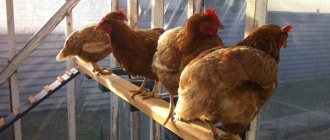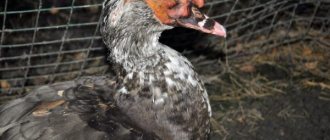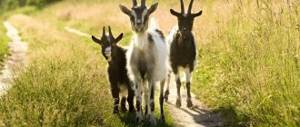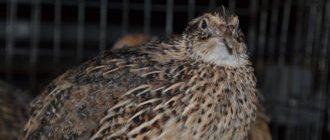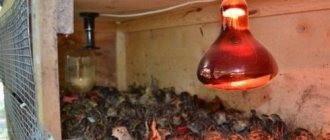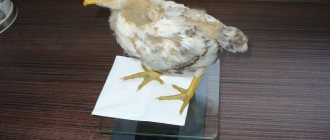Diet for laying hens at home, table for. Norms
Approximate feeding rate for laying hens in the warm season:
- cereals – 50g;
- a mixture of cereals and their processing waste (barley, oats, bran) – 50g;
- vegetables (carrots, beets, rutabaga) – 30g;
- crushed shells, chalk – 2g
- meat and bone, fish meal – 2g;
- meat waste, cake – up to 15g;
- table salt – 0.5g.
In households, the diet of laying hens consists of mixtures: grain, grass, kitchen waste and products that are offered to laying hens separately: cottage cheese, curdled milk, vegetables, legumes, potato trimmings, pieces of melons and watermelons. Birds should receive all types of feed daily.
It is advisable to partially replace fish or meat meal with earthworms. The ideal option is to specifically breed them on your farm. Some owners give their chickens grape snails. They are rich in proteins.
How to diversify your diet? During the warmer months, let your chickens roam freely in a pen. They themselves will be able to nibble the grass, find worms, larvae, and beetles. Be sure to scatter egg shells, fresh grass, and pieces of watermelon. The more varied the food, the higher the productivity of laying hens.
Tip: Medium-sized gravel or river sand will help improve digestion.
Which type of grain do you prefer?
Owners of small farms or private farmsteads do not often purchase feed or commercial mash from manufacturers due to their high cost. It is much cheaper to use grain mixtures prepared on your own farm.
If we talk about various types of food, experienced poultry farmers distinguish the following types:
recommended articles:
- How to choose effective feed for farm animals
- How much should a rabbit eat per day?
- oat grain – contains large quantities of fiber and B vitamins;
- wheat grain – increases egg productivity;
- barley grain – ideal for the combination of nutrients;
- rye grain – has a high content of protein and protein;
- Corn grain is an excellent source of carbohydrates.
Chickens peck food
Feeding chart for laying hens. Varieties of food
The task of the poultry farmer is to properly organize the feeding of laying hens. The basis of their nutrition is a mixture that includes all the substances necessary for chicken. For feeding, you can use purchased compound feed or mash - a “dish” that poultry farmers prepare themselves.
Dry feed
This is a carefully ground food that prevents overeating. A laying hen eats no more than 130 g of feed per day. The finished diet usually includes:
- crushed cereals;
- legumes;
- soy;
- sunflower cake;
- vegetable fats;
- calcium carbonate;
- salt;
- vitamin complex.
The advantage of ready-made feed is balance. Poultry farmers can purchase feed designed for specific age groups. Manufacturers also offer feed options:
- fortified;
- sunflower meal;
- yeast;
- meat and bone meal and limestone;
- vitamin and mineral complexes;
- soda, salt, chalk, sunflower oil.
- cake;
- boiled potatoes;
- vegetables;
- meal;
- bran;
- grass meal;
- cake;
- cereal.
Compound feed should be purchased from specialized stores, not from markets. It is important to study the composition of the feed. There are several options that have proven themselves excellent in feeding laying hens. For example, PC-1 is a balanced food suitable for all types of birds. It contains ingredients that increase the egg production of laying hens:
Wet food
Homemade mash is called wet food. It includes:
The mash is prepared with your own hands. The prepared mixture is steamed and mixed. Vitamins and premixes added to it are evenly distributed. Advantages of mash:
- possibility of changing the composition;
- cheaper feeding;
- variety of diet.
Chickens are omnivores and you can add anything to the mash. Wet food is ideal for feeding young animals - their bodies are not yet able to digest roughage.
The mash should not lie in the feeder for a long time - the food should be eaten a maximum of 3-4 hours after preparation. This is especially important in the summer - the mash quickly deteriorates in the heat. Stale food can cause illness and poisoning.
The mash can be made with meat or fish broth. Greens must be added to it - in summer, and in winter - sprouted grains. The mixture must have a certain consistency. Feed that is too thin can clog your chickens' nasal passages. The desired consistency is three parts dry food to one part liquid.
Cereals
Grain is a source of carbohydrates, vitamins, and fiber. Feeding one compound feed is unprofitable and impractical. At home, chickens are often fed a mixture of grains from:
- Oats. A source of protein that is easily digestible by poultry. No more than 10% oats are added to the mixture, since it contains a lot of fiber, which will take the chicken a lot of energy to digest.
- Wheat. It is 70% in the mixture. In winter, 30% of its amount can be replaced with corn.
- Barley. Ideal grain for feeding chickens. It is not given in its pure form because of its sharp ends.
- Corn. A valuable source of carbohydrates. They are given in crushed form. You should not overuse corn - it leads to obesity.
- Rye. It contains a lot of protein and vitamins. Rarely added to mixtures due to high cost.
Experienced poultry farmers advise giving chickens only crushed grain - then it will be better absorbed. Whole grains can be given to laying hens at night - then the bird will not remain hungry until the morning.
Laying hens are given 100 g of grain mixture per day. Exceeding the norm will lead to obesity and a decrease in egg production.
Top dressing
No matter how balanced the feed received by laying hens is, it is impossible to do without feeding. They are especially important:
- in spring - when daylight hours increase and egg production increases;
- in autumn - when weather conditions worsen.
Every day you need to add premixes to the feed - fertilizers that meet the birds' needs for nutrients. The composition of the supplements includes amino acids and microelements.
Twice a year, laying hens must be given a complex of vitamins - they are diluted in water.
The first thing a laying hen needs is calcium. Without it, a strong shell will not form. This element is present in the feed, but it may not be enough to meet the needs of laying hens. Source of calcium:
- shell rock;
- ground bones;
- crushed chalk;
- eggshell.
Calcium supplement is given both separately and as part of the feed. The chicken will determine the amount of calcium needed by itself - you just need to put the fertilizer in a separate feeder.
Premixes contain calcium, sodium, phosphorus, as well as amino acids that are not synthesized by the chicken body - cystine, lysine and methionine. The premixes also contain valine, arginine, histidine, threonine, tryptophan, leucine, isoleucine, phenylalanine - these substances increase egg production and improve the health of the bird. Dosage - according to the manufacturer's instructions.
Makukha for laying hens. How to feed laying hens at home?
Domestic chickens are rightfully considered one of the most picky birds. They willingly eat everything that is offered: grain, waste from the human table, weeds from the beds and the remains of feed received by pigs, sheep and goats. But it is unlikely that with such a “random” diet one can achieve high productivity. Without receiving all the nutrients, vitamins and minerals, chickens will not be able to lay eggs at full strength, and the formation of eggs will come at the expense of the bird’s body and its health.
How to organize feeding laying hens at home and choose a balanced diet for them?
In the natural environment, the wild ancestors of the chicken and its closest relatives eat a very varied diet. The menu of such birds includes grain, berries and fruits, seeds and herbs, larvae and adult insects. Birds from the order Galina do not disdain non-poisonous reptiles, for example, frogs and lizards. They hunt for earthworms and eat leaves from low-growing branches. Feeding laying hens at home cannot be so varied, but giving your pets everything they need for growth, development and good egg production is extremely important.
The concept of balanced feed and its composition
Balanced chicken feed can be called chicken feed, the daily portion of which contains the norms of proteins, carbohydrates and fats, vitamins and minerals. Complete products contain in one hundred grams:
- proteins – 15-20%;
- fat – 3%;
- fiber – 5-6%;
- calcium – 3-4%;
- phosphorus – up to 1%.
It is not necessary to purchase such concentrates for fattening and everyday feeding. It is enough to use cheaper mixtures and supplement them with greens and hay, cereals, vegetables and root vegetables, and complex additives.
The nutritional composition and regimen should be adjusted depending on the productivity and health of the bird.
Daily diet of laying hens. How much prepared feed does a laying hen need per day?
The diet of laying hens raised in households is very different from the menu of chickens on large farms. Poultry is fed with natural, selected products that have a positive effect on the number of eggs and their quality properties.
Each year, one individual eats about 40 kg of special food and 14 kg of various greens. Accordingly, the required dose per day is 120 g of feed, divided into two doses. The daily calorie content of chicken should be about 300-320 kcal, and the food should contain 20 g of pure protein and 60-70% carbohydrates.
Did you know? Eggs are formed at night, so it is recommended to feed the chicken more intensively in the evening, especially in winter.
In addition, the bird should drink approximately 300 ml of liquid per day.
These indicators are typical for feeding an adult chicken. Let's look further at how to feed chickens correctly.
For chickens
When raising the young generation of laying hens, the main task of the poultry farmer is to provide them with comfortable living conditions and nutritious, regular nutrition.
1-7 weeks
Chicks should receive their first portion of feed within 8-16 hours after hatching.
Important! Don't skip the first feeding. It has been proven that chickens that receive feed in the first hours of life subsequently become 30-35% more productive.
Small laying hens should be given food every 2-2.5 hours, following the schedule even at night. It is also necessary to provide round-the-clock access to fresh water by organizing special drinking bowls so that the birds do not get wet, as this can provoke the development of various diseases.
Chicks should not be fed whole grains until they are 4 weeks old as their digestive system will not be able to digest such heavy food. Before serving, the grains must be thoroughly chopped and steamed in water.
The optimal food for newborn chickens is a mixture of corn and barley grits mixed with a small amount of cottage cheese and one egg yolk. An obligatory product of the diet of chickens in the first days of life is greens: nettle, alfalfa. On the 5-6th day of life, you can add chopped vegetables and mineral supplements to the menu: chalk, shells, eggshells, carrots.
Older chicks are not fed as often. Their digestive organs are forming and strengthening, so various cereals, vegetables, dairy products, mineral and vitamin supplements can be added to the diet.
The approximate daily diet of laying hens at 6-7 weeks is:
- grains (barley, corn) - 15-22 g;
- skim milk - 15-20 g;
- low-fat cottage cheese - 2-3 g;
- meat and bone meal or fish meal - 1.4 g;
- cake - 0.6 g;
- greens - 15-20 g;
- boiled potatoes, root vegetables - 5-10 g;
- Mineral supplements - 1 g.
At the age of 8 weeks, laying hens switch to four meals a day, at intervals of 3.5-4 hours.
Approximate feeding standards for chickens, g per head per day
8-20 weeks
At the age of 4-5 months, the chicks begin to actively form bone and muscle tissue, and the egg-laying reserve is formed. That is why the caloric content of food is slightly reduced to 260-270 kcal per 100 g of feed. At this time, the chicken needs:
- 15-16% proteins;
- at least 5% fiber;
- calcium - 2-2.2%;
- phosphorus and sodium - 0.7% and 0.2%, respectively.
Approximate daily menu for chickens aged 8-20 weeks:
- wheat - 35 g;
- barley - 29.5 g;
- millet, bran - 10 g each;
- hydrolytic yeast - 3.5 g;
- meat and bone meal - 3 g;
- chalk, shell - 1.5 g;
- salt - 0.5 g.
At 20 weeks of age, chicks can be switched to an adult diet.
For adult chickens
An adult domestic laying hen is not only more expensive to maintain, but also requires the preparation of an individual menu, taking into account age and physiological needs.
20-45 weeks
By the end of the 45th week, the formation of the bird’s body is completely completed. At this time, she needs an increased protein content, which should be 17% of the total nutrition, and calcium, which is 3.6%. At the same time, the energy value of the feed remains at the previous level - 270 kcal/100 g.
During this period, the bird reaches its peak productivity, so it needs good, high-quality nutrition. An approximate diet looks like this (in grams):
- grains - 120 (of which corn - 40, wheat - 20, barley - 30, oats - 30);
- wet mash - 30;
- boiled potatoes - 100;
- cake - 7;
- chalk - 3;
- salt - 0.5;
- bone meal - 2;
- yeast - 1.
Approximate diet of laying hens depending on age (grams per head)
Important! It is forbidden to give green or sprouted potatoes to a chicken at any age, or to add a decoction of such root vegetables to the diet, since the solanine they contain can provoke poisoning of the bird and cause serious problems with the digestive tract.
After 45 weeks
After a chicken reaches one year, its diet changes slightly: calorie content decreases to 260 kcal/100 g, the volume of crude protein decreases to 16%, and phosphorus to 0.6%. At the same time, the percentage of calcium increases - up to 3.8%. Excess nutrients can cause a bird to rapidly gain weight and drop the number of eggs.
The meal schedule is two times a day: morning and evening. On the menu you can offer chicken (in grams):
- wheat - 50;
- barley - 40;
- corn - 10;
- bran - 20;
- chalk, shell - 3 and 5, respectively;
- bone meal - 1;
- salt - 0.5.
The diet of an adult laying hen should be based on grains (crushed or whole grains), grain mixtures and combined feeds.
Grain mixture for laying hens. Which grain is best for chickens?
For laying hens, grain mixtures are prepared from grain, they are given whole or crushed, or mash is made. For this you can use millet, wheat, buckwheat, corn, oats, barley, sunflower. The introduction of grain into the diet of chickens has a positive effect on their egg production and provides birds with the most important vitamins and microelements for them.
The grain of each of the above crops has its own positive qualities:
- Sunflower acts as a supplier of energy for the body of birds and increases their egg production. Experienced breeders recommend introducing its seeds in winter. This will increase the birds' immunity.
- Barley is mainly recommended for feeding meat birds, such as broilers. Barley can be given to chickens throughout the year. The grain of the crop has sharp tips. This can damage the birds' digestive system. Therefore, barley is mixed with other feeds.
- Millet. This grain contains a lot of fiber. Therefore, it is introduced into the diet of young chicks. Chicken can be given millet with a boiled egg. Already grown chicks are prepared with a mixture of millet, eggs and chopped greens.
- Wheat is high in calories. It contains protein, which is easily and quickly absorbed by the bird’s body. Experienced breeders give chickens not whole wheat grain, but bran from it. During the summer, they should make up no more than 80% of the chickens’ total diet, and in winter - 40%.
- Oats. It contains many vitamins necessary for the rapid growth and egg production of laying hens. How to feed oats to chickens? The grain also contains a lot of fiber. The bird's body spends a large amount of energy to digest it. Therefore, oats should not make up more than 10% of the total diet.
Peculiarities
Difficulties in feeding at different times of the year arise due to the differences in available resources. Thus, in summer it is possible to obtain succulent feed in much larger quantities.
What to feed in winter
Feeding in winter should be slightly higher in calories and carbohydrates. However, you should pay attention to the fact that due to inactivity and significant enrichment of food, obesity can develop. To prevent this, it is important to strictly follow the proposed regime and balance of feed composition.
This article will tell you about diseases of laying hens.
The main sources of proteins, carbohydrates and fats in the winter months should be grain mixtures, combined feeds and concentrates. It is also recommended to feed the bird hay and grass dust, pine and spruce needles, raw and boiled fodder root crops, and melons. During the winter season, it is recommended to install additional lighting sources. It is possible to use ordinary incandescent lamps as them. This is important not only for maintaining a high level of egg production, but also for comfortable eating. The maximum duration of daylight hours can be fourteen hours.
This link will tell you about infrared lamps for chicken coops.
In winter, to increase and maintain egg productivity, it is recommended to purchase specialized vitamin and mineral premixes for laying hens.
In summer
In the summer, feed and cereals should be the sources of the main nutritional components in the diet. They will need to be supplemented with succulent herbs and tops, fresh fruits and vegetables, and root vegetables. It is also useful to give mash of bran and broth, yogurt, vegetable and herbal decoctions.
During the day, clean water should always be present in the drinking bowls of laying hens. To ensure this, as necessary, the containers must be thoroughly washed and disinfected with a weak solution of potassium permanganate and subsequent replacement of water.
This material will tell you about drinking bowls for chickens.
